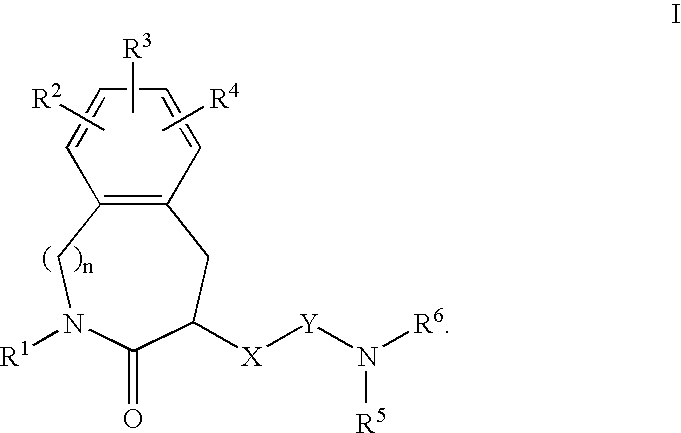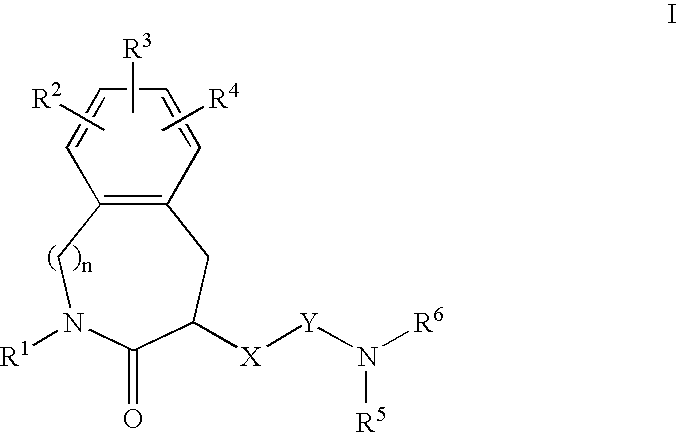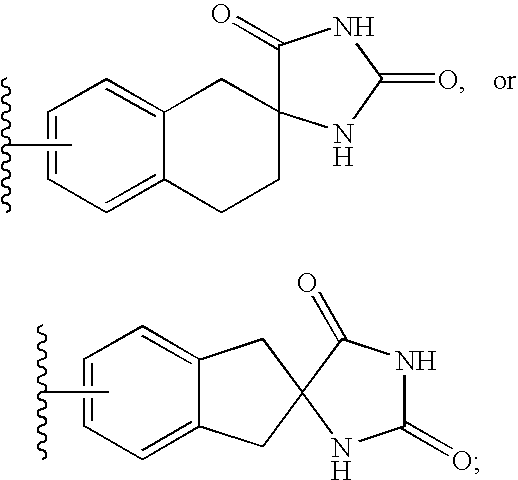Constrained compounds as CGRP-receptor antagonists
a technology of cgrp and receptor, which is applied in the direction of heterocyclic compound active ingredients, drug compositions, biocide, etc., can solve the problem of lack of molecular evidence for cgrpsub>2
- Summary
- Abstract
- Description
- Claims
- Application Information
AI Technical Summary
Benefits of technology
Problems solved by technology
Method used
Image
Examples
example 1
[0815]
[0816]4-(2-Oxo-1,4-dihydro-2H-quinazolin-3-yl)-piperidine-1-carboxylic acid (9-benzyl-8-oxo-3,6,7,8,9,10-hexahydro-2,3,9-triaza-(R)-cyclohepta[e]inden-7-yl)-amide. Potassium carbonate (25 mg, 0.18 mmol) was added to a solution of 4-(2-Oxo-1,4-dihydro-2H-quinazolin-3-yl)-piperidine-1-carboxylic acid (3-acetyl-9-benzyl-8-oxo-3,6,7,8,9,10-hexahydro-2,3,9-triaza-(R)-cyclohepta[e]inden-7-yl)-amide (19 mg, 0.03 mmol). Reaction was stirred at room temperature for 1.25 hours. Reaction was quenched with 1N hydrochloric acid (5 mL). Methanol was removed from the mixture in vacuo. Remaining aqueous was made basic with sodium bicarbonate. Mixture was extracted with dichloromethane (3×10 mL). Combined extracts were dried (magnesium sulfate), filtered and concentrated in vacuo. Title compound was obtained as an off-white solid in 90% yield. 1H NMR (300 MHz, CDCl3): δ=7.64 (s, 1H), 7.18 (m, 6H), 7.06 (m, 1H), 6.96 (t, J=7.1, 1H), 6.84 (m, 2H), 6.67 (m, 1H), 6.24 (d, J=5.9, 1H), 5.40 (m, 1H),...
example 2
[0817]
[0818]4-(2-Oxo-1,4-dihydro-2H-quinazolin-3-yl)-piperidine-1-carboxylic acid (9-methyl-8-oxo-3,6,7,8,9,10-hexahydro-2,3,9-triaza-(R)-cyclohepta[e]inden-7-yl)-amide. A catalytic amount of 10% palladium on carbon was added to a mixture of (3-acetyl-9-methyl-8-oxo-3,6,7,8,9,10-hexahydro-2,3,9-triaza-(R)-cyclohepta[e]inden-7-yl)-carbamic acid benzyl ester (30 mg, 0.07 mmol), and acetic acid (20 μL, 0.35 mmol) in methanol (6 mL) and ethyl acetate (3 mL). Reaction vessel was placed on a Parr hydrogenation apparatus and charged with 50 psi of hydrogen gas. Reaction mixture was allowed to shake at room temperature for 1.5 hours. Mixture was filtered. Filtrate was concentrated. Residue was treated with dichloromethane (3 mL) and saturated aqueous sodium bicarbonate (1 mL). 20% phosgene in toluene (48 μL, 0.09 mmol) was added to the mixture. Reaction was stirred at room temperature for 5 minutes. 4-(2-Oxo-1,4-dihydro-2H-quinazolin-3-yl) piperidinium acetate (25 mg, 0.09 mmol) was added t...
example 3
[0819]
[0820]4-(2-Oxo-1,4-dihydro-2H-quinazolin-3-yl)-piperidine-1-carboxylic acid [8-oxo-9-(2-piperidin-1-yl-ethyl)-3,6,7,8,9,10-hexahydro-2,3,9-triaza-(R)-cyclohepta[e]inden-7-yl]-amide. N,N′-Disuccinimidyl carbonate (55 mg, 0.21 mmol) was added to a mixture of 7-(R)-amino-9-(2-piperidin-1-yl-ethyl)-6,7,9,10-tetrahydro-3H-2,3,9-triaza-cyclohepta[e]inden-8-one (60 mg, 0.18 mmol) and triethylamine (150 μl, 1.1 mmol) in dichloromethane (3 mL). Reaction was stirred at room temperature for 30 minutes. 4-(2-Oxo-1,4-dihydro-2H-quinazolin-3-yl) piperidinium acetate (65 mg, 0.22 mmol) was added to the reaction mixture. Reaction was stirred until judged complete by HPLC (1.75 hours). Mixture was washed successively with water (2×5 mL) and brine (1×5 mL). Organic was concentrated in vacuo. C18 preparatory HPLC (acetonitrile-water-trifluoroacetic acid) afforded the desired product as a tan solid in 34% yield. 1H NMR (300 MHz, DMSO-D6): δ=9.23 (s, 1H), 8.34 (s, 1H), 7.43 (d, J=8.8, 1H), 7.13 (m...
PUM
| Property | Measurement | Unit |
|---|---|---|
| pH | aaaaa | aaaaa |
| volume | aaaaa | aaaaa |
| pH | aaaaa | aaaaa |
Abstract
Description
Claims
Application Information
 Login to View More
Login to View More - R&D
- Intellectual Property
- Life Sciences
- Materials
- Tech Scout
- Unparalleled Data Quality
- Higher Quality Content
- 60% Fewer Hallucinations
Browse by: Latest US Patents, China's latest patents, Technical Efficacy Thesaurus, Application Domain, Technology Topic, Popular Technical Reports.
© 2025 PatSnap. All rights reserved.Legal|Privacy policy|Modern Slavery Act Transparency Statement|Sitemap|About US| Contact US: help@patsnap.com



